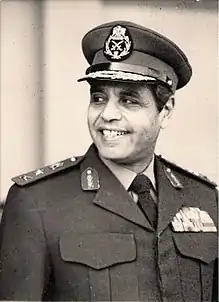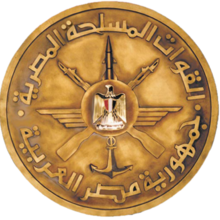Mohammed Aly Fahmy
Mohammed Aly Fahmy (11 October 1920 – 11 September 1999) was an Egyptian field marshal, known as the "Father of the Egyptian Air Defense".
Mohammed Aly Fahmy | |
|---|---|
 | |
| Chief of Staff of the Egyptian Armed Forces | |
| In office 3 January 1975 – 4 October 1978 | |
| President | Anwar Sadat |
| Preceded by | Mohamed Abdel Ghani el-Gamasy |
| Succeeded by | Ahmed Badawi |
| Commander of the Egyptian Air Defense Command | |
| In office September 1968 – January 1975 | |
| President | Gamal Abdel Nasser Anwar Sadat |
| Preceded by | Title created |
| Succeeded by | Helmy Afify Abd El-Bar |
| Personal details | |
| Born | 11 October 1920 |
| Died | 11 September 1999 |
| Military service | |
| Allegiance | |
| Branch/service | |
| Years of service | 1940–1978 |
| Rank | |
| Unit | 12th Cavalry |
Early career
Fahmy graduated from the Egyptian Military Academy in 1940. He was commissioned in a cavalry unit and initially commanded armored platoons and squadrons equipped with Cruiser Mk I, Mk II, Crusader and Sherman tanks. In 1952 he was in command of an armored battalion at Alexandria and was crucial during the July coup.
Military years
In 1953, he was made an executive staff officer in the Defense Ministry. In 1954 he was promoted to the rank of Colonel. From 1955 onwards he became interested in the concept of Air Defense and proposed to President Nasser to further extend the existing Air Defense units in the Army which until then was only based on British 20mm Flak guns. Between 1957 and 1961, six Air Defense battalions, grouped under 2 Brigades were raised from scratch under his supervision as General Staff Officer-II in charge of Operations in the Army HQ. From 1957–59 he studied in the Soviet Union the concepts and practicals of Air Defense, and came back to command an Air Defense Brigade. Since the 1930s, Air Defense was considered to be a "combat support" arm of the regular Army and was considered less prestigious than the 'combat arms' of Infantry, Cavalry and Field Artillery. He was made a Major General in 1963. In 1964, he completed a PhD in the Soviet Union on Air Defense strategy and became the commander of one of the only two Air Defense Divisions in the Army. He participated in World War II, the 1948 Arab–Israeli War, the Suez Crisis, the Six-Day War, the War of Attrition and the Yom Kippur War.
Military influence
After the debacle of 1967, he prevailed upon Nasser to make the Air Defense a separate branch of the Armed Forces, based on the Soviet model. Between 1968 and 1971 he raised five new Air Defense Brigades and two new Air Defense Divisions, plus established an Air Defense Academy in 1970 for the training of young officers and conscripts. He was the first commander of the Egyptian Air Defense Command from September 1968 to January 1975 and Chief of Staff of the Egyptian Armed Forces from January 1975 to October 1978. In this capacity he was also the Deputy Chairman of the Supreme Council of the Armed Forces and a close aide to President Sadat.[1]
Legacy
He is mostly known for his planning and management of the Egyptian Air Defense Command during the Attrition War and 6 October war and for building "the Egyptian Missile Wall". He resigned as Chief-of-Staff of the Armed Forces owing to opposition with Egypt's rapprochement with Israel and due to his conflict and rivalry with Hosni Mubarak, a man several years his junior but becoming more important than him in the corridors of power during the Sadat era. He retired to live in Iraq from 1980 onwards.
References
- Aly Fahmy, Mohammed. "Biography of Mohammed Aly Fahmy". mmc.gov.eg. Archived from the original on 24 March 2011. Retrieved 15 July 2013.
| Military offices | ||
|---|---|---|
| Preceded by Mohamed Abdel Ghani el-Gamasy |
Chief of Staff of the Egyptian Armed Forces 3 January 1975 – 4 October 1978 |
Succeeded by Ahmed Badawi |
| Military offices | ||
|---|---|---|
| Preceded by Title created |
Commander of the Egyptian Air Defence Forces September 1968 – January 1975 |
Succeeded by Helmy Afify Abd El-Bar |
